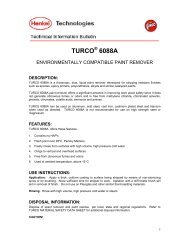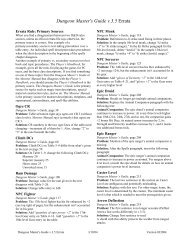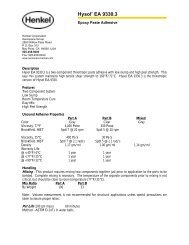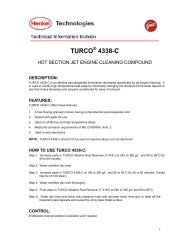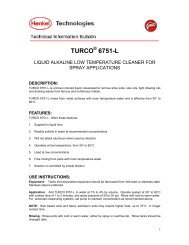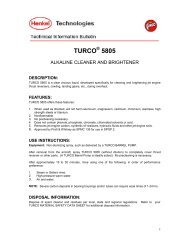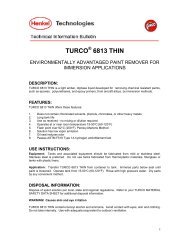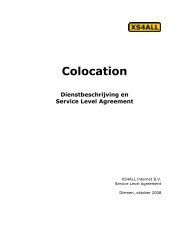3. Experimental Procedures Synthetic pathways en route ... - Xs4all
3. Experimental Procedures Synthetic pathways en route ... - Xs4all
3. Experimental Procedures Synthetic pathways en route ... - Xs4all
Create successful ePaper yourself
Turn your PDF publications into a flip-book with our unique Google optimized e-Paper software.
<strong>3.</strong> <strong>Experim<strong>en</strong>tal</strong> <strong>Procedures</strong><br />
experim<strong>en</strong>tal procedures<br />
<strong>Synthetic</strong> <strong>pathways</strong> <strong>en</strong> <strong>route</strong> towards<br />
desirable transfer ag<strong>en</strong>ts<br />
» Desire pulls<br />
stronger than<br />
experi<strong>en</strong>ce<br />
« 1<br />
Synopsis: This chapter pres<strong>en</strong>ts an overview of various possible <strong>route</strong>s that<br />
yield dithioesters, structures suitable as transfer ag<strong>en</strong>ts for reversible<br />
addition–fragm<strong>en</strong>tation reactions. Though not all of these <strong>route</strong>s were actively<br />
explored, they do provide a guideline for future syntheses, indicating specific<br />
advantages and drawbacks of the various approaches. Furthermore, the<br />
experim<strong>en</strong>tal part of this chapter details the synthesis of all transfer ag<strong>en</strong>ts used<br />
in this thesis, thereby providing examples of several of the aforem<strong>en</strong>tioned<br />
synthetic <strong>pathways</strong>.<br />
<strong>3.</strong>1. Introduction<br />
In chapter 2 the g<strong>en</strong>eral structure of the RAFT ag<strong>en</strong>ts applied in this study was<br />
introduced along with several specific examples. Although numerous differ<strong>en</strong>t<br />
structures may permit reversible addition–fragm<strong>en</strong>tation chain transfer reactions, it<br />
was already pointed out that several classes of sulfur containing species are especially<br />
designed to be applied as such. Dithioesters are unsurpassed in activity by<br />
xanthates, trithiocarbonates and thiocarbamates which can be used as well. The<br />
work in this thesis makes use exclusively of aromatic dithioesters that contain a<br />
dithiob<strong>en</strong>zoate moiety. An overview will be pres<strong>en</strong>ted to the reader detailing the<br />
most common known synthetic <strong>pathways</strong> to such dithioesters. Furthermore, the<br />
experim<strong>en</strong>tal details on the synthesis of several dithiob<strong>en</strong>zoate esters are provided.<br />
For clarity and consist<strong>en</strong>cy, g<strong>en</strong>eral reaction schemes will make use of Z and R to<br />
63
Chapter 3<br />
Scheme <strong>3.</strong>1. Nucleophilic substitution of an alkyl halyde by a dithiocarboxylate salt forming a<br />
dithioester. The dithiocarboxylate can be an alkali(-earth) or ammonium salt.<br />
indicate the activating group and the leaving group of the RAFT ag<strong>en</strong>t in the same<br />
way as in chapter 2 (see Scheme 2.8 on page 27). By doing so, one can quickly<br />
id<strong>en</strong>tify the starting materials needed to prepare a specific RAFT ag<strong>en</strong>t via the<br />
various <strong>pathways</strong> outlined in this chapter.<br />
<strong>3.</strong>2. <strong>Synthetic</strong> Approaches to Dithioesters<br />
<strong>3.</strong>2.1. Substitution Reactions with Dithiocarboxylate Salts.<br />
The approach first requires the formation of a dithiocarboxylic acid salt which<br />
can be prepared in a number of differ<strong>en</strong>t ways, which are outlined below. The<br />
dithiocarboxylate takes the role as nucleophile in substitution reactions with e.g.<br />
alkyl halides that are added directly to the reaction mixture or to the salts after<br />
isolation (Scheme <strong>3.</strong>1). Most dithiocarbonate salts (alkali and alkali-earth) have a<br />
limited stability and should be used directly after preparation without isolation or<br />
ext<strong>en</strong>sive purification. 2,3 For conservation purposes, the conversion to an<br />
ammonium salt (in particular the piperidinium salt) appears to be the only acceptable<br />
option. These crystalline salts have be<strong>en</strong> reported to be fairly stable. They<br />
allow facile g<strong>en</strong>eration of the free acid or can be used directly in substitution reactions.<br />
4,5,6 Stable lead and zinc salts have be<strong>en</strong> prepared as well for id<strong>en</strong>tification<br />
processes but these lack synthetic utility. 7,8,9 Both the ammonium and the alkali(earth)<br />
salts can serve as nucleophiles in substitution reactions of alkyl halides, alkyl<br />
sulfates or alkyl sulfonates to produce the desired dithioesters. 6,10,11,12 Wh<strong>en</strong> the<br />
substitution reaction is omitted, the dithioacid can be obtained by protonation of the<br />
salt with a strong acid. The dithioacid in turn can be converted to a dithioester by<br />
several other <strong>route</strong>s discussed in the sections <strong>3.</strong>2.2, <strong>3.</strong>2.3 and <strong>3.</strong>2.7.<br />
64
from Aromatic Mono-, Di- and Trihalidemethylates<br />
experim<strong>en</strong>tal procedures<br />
Scheme <strong>3.</strong>2. a) Conversion of b<strong>en</strong>zotrichloride to potassium dithiob<strong>en</strong>zoate. b) Conversion of aromatic<br />
monohalidemethylates to dithio carboxylates by the reaction with elem<strong>en</strong>tal sulfur and alkali alkoxylates.<br />
Both reactions take place in an alcoholic medium.<br />
The first syntesis of a dithiocarboxylate was reported by Fleischer13 who<br />
prepared dithiob<strong>en</strong>zoic acid from b<strong>en</strong>zalchloride (C6H5CHCl2 ) and potassium sulfhydrate<br />
in ethanol and water, which yielded traces of the acid as a red oil upon the<br />
addition of hydrochloric acid. Wood et al. 14 later showed that the success of this<br />
synthesis was most likely due to impurities in the potassium sulfhydrate, most<br />
notably potassium sulfide. The latter reacts with b<strong>en</strong>zal chloride to form thiob<strong>en</strong>zaldehyde<br />
as an unstable intermediate which, dep<strong>en</strong>ding on the reaction conditions,<br />
can undergo the Cannizzaro reaction to yield potassium dithiob<strong>en</strong>zoate amongst<br />
other products.<br />
B<strong>en</strong>zotrichloride can be converted to potassium dithiob<strong>en</strong>zoate by slow<br />
addition to a susp<strong>en</strong>sion of potassium sulfide in boiling methanol (Scheme <strong>3.</strong>2, a). 15<br />
The reaction is exothermic and needs to be cooled once it has started.<br />
Another method to come to aromatic dithiocarboxylates is docum<strong>en</strong>ted by<br />
Becke and Hag<strong>en</strong>. 16 Here, aromatic monohalidemethylates are treated with<br />
elem<strong>en</strong>tal sulfur and (earth) alkali alkoxydes (Scheme <strong>3.</strong>2, b). The synthesis is compatible<br />
with a variety of substitu<strong>en</strong>ts on the aromatic ring. Alkyl, alkoxy and<br />
halog<strong>en</strong> groups remain untouched while additional methylhalide groups will lead to<br />
multiple dithiocarboxylates moieties. This approach is tak<strong>en</strong> in the synthesis of 2ph<strong>en</strong>ylprop-2-yl<br />
dithiob<strong>en</strong>zoate (section <strong>3.</strong>4.3, page 79). The methods outlined in<br />
Scheme <strong>3.</strong>2 typically produce a variety of side products and salts and some degree<br />
of purification will be required before substitution reactions are performed.<br />
65
Chapter 3<br />
Scheme <strong>3.</strong><strong>3.</strong> The Grignard synthesis. The reaction betwe<strong>en</strong> a Grignard reag<strong>en</strong>t and carbon disulfide<br />
yields a reactive dithiocarboxilic acid salt which may be qu<strong>en</strong>ched and acidified to access the protonated<br />
acid or alternatively, an alkyl halide may be added to participate in a nucleophilic substitution.<br />
66<br />
from Grignard Reactions<br />
Houb<strong>en</strong>7 was the first to report the use of Grignard salts in the synthesis of<br />
dithioacids. Arylmagnesiumhalides were allowed to react with carbon disulfide in<br />
dry ether, producing the magnesiumhalide salt of the corresponding dithioacid.<br />
These reactive species can be transformed directly into a dithioester by addition of a<br />
suitable alkyl halide or alkyl sulfate17,7 to the reaction mixture. The literature<br />
reports reasonable yields for the coupling of especially aromatic but also of<br />
aliphatic intermediates with alkyl iodides and bromides. 12 RAFT ag<strong>en</strong>ts, applicable<br />
to a wide range of monomers, g<strong>en</strong>erally require a tertiary halide (e.g. tert-butyl<br />
bromide) to be coupled to the active intermediate. The alkyl halide will form the Rgroup<br />
and needs to possess a good homolitic leaving-group character. Unsuprisingly,<br />
such groups are the most difficult to attach to the dithio carbonate moiety in<br />
the first place. This <strong>route</strong> was followed for the synthesis of 2-(ethoxycarbonyl)prop-<br />
2-yl dithiob<strong>en</strong>zoate which is detailed in section <strong>3.</strong>4.2. According to Meijer et al. 18<br />
the procedure can be optimized in several ways. First, the yield improved considerably<br />
wh<strong>en</strong> tetrahydrofuran was used as the reaction medium instead of ether.<br />
Second, the reaction rate of alkyl magnesium chlorides was found to be higher than<br />
that of the corresponding bromides in both the formation of the dithiocarbonate<br />
intermediate and that of the final ester, which could proove useful for the preparation<br />
of dithioesters with more sterically hindered R-groups. Third, it was found that<br />
reactions could be conducted at much lower temperatures wh<strong>en</strong> 10–20%<br />
hexamethylphosphoramide (HMPA, [(CH3 ) 2N] 3PO) was added to the reaction. The<br />
alkylation of e.g. C2H5C(S)SMgBr with CH3I could be conducted at –35°C<br />
whereas the same reaction without HMPA requires 30 to 40°C to proceed at an<br />
acceptable rate. Although they only showed the temperature effect for relatively
experim<strong>en</strong>tal procedures<br />
easy-coupling alkyl halides, the results could imply that also the yields for tertiary<br />
halides would b<strong>en</strong>efit from the addition of HMPA. Westmijze et al. 19 found that the<br />
addition of catalytic amounts of copper(I)bromide to Grignard reaction significantly<br />
increased the yield of several dithioesters derived from rather unreactive<br />
starting materials. The more reactive organocopper intermediates allowed the preparation<br />
of dithioesters with sterically hindered and unsaturated Z-groups.<br />
Beside the direct esterification of the dithiocarbonate magnesiumhalide, the<br />
Grignard may also be qu<strong>en</strong>ched at this point with water and a strong acid, to gain<br />
access to dithiocarboxylic acid. These acids are g<strong>en</strong>erally very unstable and should<br />
not be isolated as such. 12,15,20 They are readily oxidized by oxyg<strong>en</strong> to bis(thioalkyl)disulfides<br />
and should be used directly in further reactions or be converted to<br />
more stable ammonium salts. The formation of the acid is performed in the<br />
synthesis of 2-cyanoprop-2-yl dithiob<strong>en</strong>zoate (section <strong>3.</strong>4.4, page 80).<br />
from Aromatic Aldehydes<br />
Gonella et al. 21 reported a conv<strong>en</strong>i<strong>en</strong>t <strong>route</strong> to come to aromatic dithioesters<br />
using b<strong>en</strong>zaldehyde (1) as the starting material (Scheme <strong>3.</strong>4). Reacting this<br />
compound with ethanedithiol (2) in the pres<strong>en</strong>ce of a catalytic amount of p-tolu<strong>en</strong>esulfonic<br />
acid affords a thioketal (3). Wh<strong>en</strong> a solution of the thioketal in dimethylformamide<br />
(DMF) and hexamethylphosphoramide (HMPA) is treated with sodium<br />
hydride and an alkyl halide a dithioester is formed in varying yields (40 –90%). The<br />
addition of the alkyl halide may also be ommited to gain access to the sodium salt<br />
of the aromatic dithioacid. The method has the advantage that it is tolerant to<br />
various functional groups on the aromatic ring.<br />
Aromatic aldehydes can also serve as the starting material for the reaction with<br />
ammonium polysulfides. This approach was pioneered by Bost and Shealy22 and<br />
later followed by J<strong>en</strong>s<strong>en</strong> and Peders<strong>en</strong>. 23 The method is tolerant to various functional<br />
groups but gives only low to moderate yields (20–40%).<br />
<strong>3.</strong>2.2. Addition of Dithio Acids to Olefins<br />
The dithioacid in its protonated form can add to olefins to yield various<br />
dithioesters. 24 The ambival<strong>en</strong>t character of the dithioacid functionality allows<br />
addition to proceed by either a nucleophilic or electrophilic mechanism, dep<strong>en</strong>ding<br />
on the nature of the olefin. Electrophilic olefins like acrylonitrile and vinylpyridine<br />
force the dithioacid to act as nucleophile. The reactions with (meth)acrylonitrile<br />
67
Chapter 3<br />
Scheme <strong>3.</strong>4. a) The conversion of b<strong>en</strong>zaldehyde to the sodium dithiob<strong>en</strong>zoate via a thioketal and subsequ<strong>en</strong>t<br />
esterification. b) Reaction betwe<strong>en</strong> b<strong>en</strong>zaldehyde and ammonium polysulfide of average composition<br />
(NH4 ) 2S2 . 22<br />
and (meth)acrylic acid and their esters give dithioesters where the sulfur-containing<br />
group becomes attached to the least substituted side of the carbon-carbon double<br />
bond, making it ineffici<strong>en</strong>t raft ag<strong>en</strong>ts (Scheme <strong>3.</strong>5, a). Few electrophilic olefins<br />
exist that would result in good RAFT ag<strong>en</strong>ts of which the addition to mesityl oxide<br />
(4-methyl-3-p<strong>en</strong>t<strong>en</strong>-2-one) is an example. This would give a dithioester possessing<br />
a good homolytic leaving group (Scheme <strong>3.</strong>5, b).<br />
The reaction with nuclephilic olefins obeys Markovnikov's rule. The olefin is<br />
protonated and the resulting carbocation combines with the negatively charged<br />
dithiocarboxylate group. The reaction with α-methylstyr<strong>en</strong>e yields 2-ph<strong>en</strong>ylprop-2-yl<br />
dithiob<strong>en</strong>zoate (Scheme <strong>3.</strong>5, c). <strong>Experim<strong>en</strong>tal</strong> details of this synthesis are<br />
found in section <strong>3.</strong>4.<strong>3.</strong><br />
<strong>3.</strong>2.<strong>3.</strong> Thioalkylation of Thiols and Thiolates.<br />
Thiols and alkali thiolates can be converted into dithioesters by thioacylation<br />
with e.g. bis(thioacyl) sulfides (4), thioacyl halides (5) and dithioesters (6, 7,<br />
Scheme <strong>3.</strong>6). These reactions typically proceed in good to excell<strong>en</strong>t yields<br />
(70–95%) and the main advantage over the use of dithio acid salts lies in the<br />
increased reactivity of the thioacylating species. The reaction can be considered as<br />
a nucleophilic displacem<strong>en</strong>t at the thiocarbonyl carbon by a sulfur nucleophile.<br />
68
experim<strong>en</strong>tal procedures<br />
Scheme <strong>3.</strong>5. a) Nucleophilic addition of dithiob<strong>en</strong>zoic acid to the carbon–carbon double bond of<br />
methyl methacrylate. The concerted mechanism of the addition is speculative. 24 The result is a RAFT<br />
ag<strong>en</strong>t with a poor homolytic leaving group. b) Nucleophilic addition of dithiob<strong>en</strong>zoic acid to mesityl<br />
oxide. The result is a RAFT ag<strong>en</strong>t with a good homolytic leaving group. c) Electrophilic addition of<br />
dithiob<strong>en</strong>zoic acid to α-methylstyr<strong>en</strong>e. The nucleophilic olefin is protonated, followed by the electrophilic<br />
attack of the sulfur.<br />
Bis(thioacyl) sulfides (4) are prepared by the reaction betwe<strong>en</strong> dithio acids and 1,3dicyclohexylcarbodiimide<br />
(DCC). The reaction betwe<strong>en</strong> 4-methyl dithiob<strong>en</strong>zoic<br />
acid and half an equival<strong>en</strong>t of DCC in hexane at 0°C gave bis(4-methylthiob<strong>en</strong>zoyl)<br />
sulfide in 80% yield. 25 Thioacyl halides (5) are prepared from dithioacids and<br />
thionyl chloride. In the case of dithiob<strong>en</strong>zoic acid, the reaction completes with 50 to<br />
61% yield. 26,27<br />
Methyl dithiob<strong>en</strong>zoate (6) has be<strong>en</strong> prepared in 50–90% yield by various<br />
methods oulined in section <strong>3.</strong>2.1. 18,21 The transesterification of 6 and 7 can be considered<br />
as a special case of thioacylation of mercaptanes. The thioacylating ag<strong>en</strong>t is<br />
in this case a dithioester itself. The process can be used to convert dithioesters that<br />
are easily prepared (e.g. methyl dithiob<strong>en</strong>zoate, 6) or commercially available (e.g.<br />
69
Chapter 3<br />
Scheme <strong>3.</strong>6. Thioalkylation of thiolates. Thiols and alkali thiolates can be converted into dithioesters<br />
by thioacylation with bis(thioacyl) sulfides (4), thioacyl halides (5) and dithioesters(6, 7).<br />
S-(thiob<strong>en</strong>zoyl)thioglycollic acid, 7, Scheme <strong>3.</strong>6) to more suitable RAFT ag<strong>en</strong>ts. 28<br />
These reactions take place selectively in the pres<strong>en</strong>ce of other functional groups<br />
like hydroxides. 29 An equilibrium is established but this can be shifted <strong>en</strong>tirely to<br />
the product side by removal of the volatile methanethiol (b.p. 6°C) in the case of 6.<br />
The reaction of 7 can be conducted in aqueous solution from which the hydrophobic<br />
dithioester separates. If the mercaptane is insoluble in water, a suitable organic<br />
medium will have to be found and the equilibrium can be shifted to the product side<br />
by washing the organic phase with an alkaline solution to prefer<strong>en</strong>tially remove<br />
thioglycollic acid (8). The main disadvantage lies in the fact that besides a suitable<br />
thioacylating ag<strong>en</strong>t, the desired R group (Scheme <strong>3.</strong>6) should be available in the<br />
form of a mercaptane. The supply of tertiary mercaptanes is limited to e.g. tertbutyl<br />
mercaptane and tert-dodecyl mercaptane, but nontheless, for these compounds,<br />
the <strong>route</strong>s pres<strong>en</strong>ted in this section may be favoured to the substitution<br />
reactions of section <strong>3.</strong>2.1, due to the higher yields.<br />
70
<strong>3.</strong>2.4. via Imidothioate Intermediates<br />
experim<strong>en</strong>tal procedures<br />
Scheme <strong>3.</strong>7. Preparation of imidothioate esters and subsequ<strong>en</strong>t conversion to dithioesters with hydrog<strong>en</strong><br />
sulfide.<br />
Treatm<strong>en</strong>t of imidothioates (12, Scheme <strong>3.</strong>7) with hydrog<strong>en</strong> sulfide under<br />
acidic conditions is a widely used method to prepare dithioesters because of the<br />
broad range of available precursors. The imidothioate ester can be derived from a<br />
number of starting materials, viz. nitriles 30 (9), thioamides 31 (10) and<br />
isothiocyanates32 (11). The yields of the process range from moderate to good<br />
(50–90%), but like in the majority of other <strong>route</strong>s, the R group should be available<br />
in the form of a halide or a mercaptane.<br />
<strong>3.</strong>2.5. with Sulfur Organo-Phosphorus Reag<strong>en</strong>ts<br />
Thiolesters (ZCOSR) are converted to dithioesters by the action of various<br />
sulfur organo-phosphorus reag<strong>en</strong>ts. Wh<strong>en</strong> exposed to 2,4-bis(4-methoxyph<strong>en</strong>yl)-<br />
1,3-dithia-2,4-diphosphetane-2,4-disulfide (Lawesson’s reag<strong>en</strong>t, 13, Scheme <strong>3.</strong>8)<br />
dithioesters are obtained in high yields (≥90%). 33,34 The thiolesters themselves are<br />
obtained from the esterification reaction of thiols and carboxilic acids. 35,36,37 Unlike<br />
the esterification of carboxilic acids and alcohols, this reaction is not succesfully<br />
catalyzed by protons alone, but requires an activator like 1,3-dicyclohexylcarbodiimide<br />
to shift the equilibrium to a more favorable position. 38 Alternatively, thiols<br />
71
Chapter 3<br />
Scheme <strong>3.</strong>8. Structure of Lawesson’s reag<strong>en</strong>t (13) and various intermediates (14, 15) that are formed<br />
in the reaction betwe<strong>en</strong> alcohols, diphosphorus p<strong>en</strong>tasulfide and carboxylic acids.<br />
can be reacted with acyl halides (ZCOCl) under mild conditions, catalyzed by<br />
tertiary amines, 39 or the thiolesters can be obtained from the reaction betwe<strong>en</strong><br />
carbonyl sulfide and Grignard salts. 40<br />
O,O-dialkyldithiophosphoric acids (14, Scheme <strong>3.</strong>8) can be used to convert<br />
carboxylic acids directly to dithioesters in moderate yields. 41 The O,O-dialkyldithiophosphoric<br />
acids are prepared from alcohols and diphosphorus p<strong>en</strong>tasulfide.<br />
If an excess of the latter is applied, the reaction proceeds to ultimately form trialkyl<br />
tetrathiophosphates (15), 42 which react with carboxylic acids in higher yields. Davy<br />
and Metzner43 showed that the procedure can be simplified to a one pot synthesis,<br />
directly converting carboxylic acids and alcohols into dithioesters with diphosphorus<br />
p<strong>en</strong>tasulfide in moderate to good yields (40–90%) for methyl and ethyl esters.<br />
Although the method uses conv<strong>en</strong>i<strong>en</strong>t starting materials and allows for upscaling,<br />
the applicability to secondary and tertiary alcohols remains unexplored.<br />
<strong>3.</strong>2.6. Friedel-Crafts Chemistry<br />
An alternative <strong>route</strong> to (substituted) dithiob<strong>en</strong>zoate esters is reported by Viola<br />
et al. 44 In their approach, the dithiocarbonate group is first attached to the R-group<br />
to form a reactive chlorodithioformic acid ester (17), which, under Friedel-Crafts<br />
conditions, adds to activated ar<strong>en</strong>es in high yields (Scheme <strong>3.</strong>9, b). The chlo-<br />
72
experim<strong>en</strong>tal procedures<br />
Scheme <strong>3.</strong>9. Synthesis of dithioesters by Friedel-Crafts reactions. a) Preparation of chlorodithioformic<br />
acid ester. b) Coupling betwe<strong>en</strong> the chlorodithioformic acid ester and a b<strong>en</strong>z<strong>en</strong>e ring. c) Participation of<br />
carbon disulfide in selective Friedel-Crafts reactions.<br />
rodithioformic acid esters themselves are prepared from the reaction betwe<strong>en</strong> thio-<br />
phosg<strong>en</strong>e (16) and mercaptanes 45 or from dithio acids and thionyl chloride. 46 The<br />
first process takes place with 80–90% yield in the case of methyl mercaptane. 45 For<br />
RAFT synthesis a tertiary mercaptane would be desired which is commercially<br />
available in e.g. tert-dodecylmercaptane. The branched alkyl would make a good<br />
leaving group and has the additional advantage that the behavior of the radical has<br />
be<strong>en</strong> thoroughly investigated in both homog<strong>en</strong>eous and heterog<strong>en</strong>eous polymerization<br />
systems, as it is used as a chain transfer ag<strong>en</strong>t itself. 47 The coupling of the chlorodithioformic<br />
acid ester to an aromatic ring is unlikely to be influ<strong>en</strong>ced strongly by<br />
the R-group but largely dep<strong>en</strong>ds on the substitu<strong>en</strong>ts on the b<strong>en</strong>z<strong>en</strong>e ring. With<br />
methyl, methoxy, hydroxyl or halog<strong>en</strong> substitu<strong>en</strong>ts, the dithioesters were obtained<br />
in 60–95% yield. The hydroxyl substituted aromatic ring is inaccessable by the<br />
Grignard method, besides, differ<strong>en</strong>tly substituted b<strong>en</strong>z<strong>en</strong>es are more easily<br />
available than their brominated analogues that are required in the Grignard synthesis.<br />
Another report on the formation of dithioesters using Friedel-Crafts chemistry<br />
comes from George, 48 who described a one pot synthesis of trimethylsilylmethyl<br />
dithiob<strong>en</strong>zoate (19) from a mixture of b<strong>en</strong>z<strong>en</strong>e, carbon disulfide and (chloromethyl)methyldichlorosilane<br />
(18). The success of this method strongly dep<strong>en</strong>ds on the<br />
73
Chapter 3<br />
Scheme <strong>3.</strong>10. Formation of bis(thiob<strong>en</strong>zoyl)disulfide (20) via the oxidative coupling of dithiob<strong>en</strong>zoic<br />
acid by dimethyl sulfoxide.<br />
structure of the alkyl halog<strong>en</strong>ide as in numerous other accounts, carbon disulfide is<br />
used as an inert solv<strong>en</strong>t for the coupling betwe<strong>en</strong> the alkyl halog<strong>en</strong>ide and the<br />
aromatic ring. The details of the mechanism remain unclear, however, as the<br />
aluminium chloride appears to be a reactant rather than a catalyst.<br />
<strong>3.</strong>2.7. via Bis(thioacyl)disulfides<br />
A novel addition to the field of synthetic <strong>route</strong>s is that of the reaction betwe<strong>en</strong><br />
carbon-c<strong>en</strong>tered radicals and bis(thioacyl)disulfides. 49,50,51 The bis(thioacyl)disulfides<br />
(20) are prepared by oxidative coupling of dithioacids or their salts. Most<br />
dithioacids are oxidized by oxyg<strong>en</strong> from the air, or in a more rapid and controlled<br />
manner by other mild oxidizing ag<strong>en</strong>ts like iodine or hydrog<strong>en</strong> peroxide. Stronger<br />
oxidizers like potassium permanganate typically destroy the dithiocarbonate<br />
moiety. The coupling of dithiocarboxylates with iodine is an established process. 7,10<br />
In the case of dithiob<strong>en</strong>zoate salts, the reaction is typically conducted in an aqueous<br />
medium from which the product precipitates. This procedure has be<strong>en</strong> attempted<br />
initially in the synthesis of 2-cyanoprop-2-yl dithiob<strong>en</strong>zoate, which is described in<br />
section <strong>3.</strong>4.4 on page 80. A very large amount of potassium iodide was needed to<br />
solubilize the required iodine in the water phase and the large reaction volume complicated<br />
upscaling. Besides, the product did not precipitate in crystals but separated<br />
out in the form of a sticky oil-like layer which was difficult to purify. The reaction<br />
74
experim<strong>en</strong>tal procedures<br />
Scheme <strong>3.</strong>11. Preparation of dithioesters by radical reactions. a) Radicals are g<strong>en</strong>erated by the dissociation<br />
of an initiator. b) Reaction betwe<strong>en</strong> a radical and the bis(thioacyl)disulfide g<strong>en</strong>erates a dithioester<br />
molecule and a relatively stable dithiob<strong>en</strong>zoate radical (21). c) The dithiob<strong>en</strong>zoate radical (21) recombines<br />
with a initiator derived radical R, forming another instance of the dithioester.<br />
can be conducted under more conv<strong>en</strong>i<strong>en</strong>t conditions wh<strong>en</strong> dimethyl sulfoxide is<br />
used for the oxidation (Scheme <strong>3.</strong>10). 24 The reaction could be performed in an op<strong>en</strong><br />
vessel at ambi<strong>en</strong>t conditions in bulk or in solution and produced bis(thiob<strong>en</strong>zoyl)disulfide<br />
in excell<strong>en</strong>t yield (>90%, based on crude dithiob<strong>en</strong>zoic acid).<br />
Carbon-c<strong>en</strong>tered radicals react with bis(thioacyl)disulfides (20) by the<br />
mechanism postulated in Scheme <strong>3.</strong>11. 50 The radicals are g<strong>en</strong>erated by a conv<strong>en</strong>tional<br />
azo initiator (Scheme <strong>3.</strong>11, a) in the first step and these react with a bis(thioacyl)disulfides,<br />
forming a dithioester together with a sulfur c<strong>en</strong>tered radical (21).<br />
This radical in turn can recombine with a carbon-c<strong>en</strong>tered radical to form the same<br />
dithioester species (Scheme <strong>3.</strong>11, c). The advantage of this process is that functional<br />
and sterically hindered R groups can be introduced with great ease and<br />
without the formation of many side products. The only significant contamination is<br />
the product of the reaction betwe<strong>en</strong> two carbon-c<strong>en</strong>tered radicals. The reaction<br />
betwe<strong>en</strong> two sulfur-c<strong>en</strong>tered radicals reg<strong>en</strong>erates the starting material (20), while<br />
the reaction betwe<strong>en</strong> a carbon-c<strong>en</strong>tered radical and the dithioester is deg<strong>en</strong>erate, i.e.<br />
the products are id<strong>en</strong>tical to the reactants. This <strong>route</strong> is followed in the synthesis of<br />
2-cyanoprop-2-yl dithiob<strong>en</strong>zoate (section <strong>3.</strong>4.4)<br />
75
Chapter 3<br />
<strong>3.</strong><strong>3.</strong> Conclusion<br />
It is hard to recomm<strong>en</strong>d any of the aform<strong>en</strong>tioned syntheses as ideal or the best.<br />
In terms of overall yield, values giv<strong>en</strong> in the literature for the various <strong>route</strong>s can<br />
hardly be compared because of the large discrepancies betwe<strong>en</strong> primary, secondary<br />
and tertiary R groups. Within a certain <strong>route</strong>, the structure of the R group seems to<br />
be the ‘yield-determining’ factor. This is especially true for the most frequ<strong>en</strong>tly<br />
applied substitution reactions discussed in section <strong>3.</strong>2.1. The other chemistries<br />
intuitively do not seem to be affected so strongly by the structural details of the R<br />
group, but this hypothesis lacks experim<strong>en</strong>tal conformation. If this indeed proves to<br />
be the case, th<strong>en</strong> tertiary thiols – commercially available in the form of tert-butyl<br />
mercaptane or tert-dodecyl mercaptane – will form interesting compounds for thioacylation<br />
(section <strong>3.</strong>2.3) or a useful ingredi<strong>en</strong>t for the procedures outlined in the<br />
sections <strong>3.</strong>2.4, <strong>3.</strong>2.5 and <strong>3.</strong>2.6. Wh<strong>en</strong> it comes to functionalized R groups, the<br />
reaction of bis(thioacyl)disulfides with radicals derived from azo initiators remains<br />
the author’s top-notch pick, because of the large variety of initiators available on<br />
the market nowadays. For a further overview of all the dithioesters that have be<strong>en</strong><br />
prepared by the various <strong>route</strong>s up to 1988 refer<strong>en</strong>ce 52 can be consulted, while a<br />
larger overview of the synthetic <strong>pathways</strong> can be found in refer<strong>en</strong>ce 53 as well.<br />
<strong>3.</strong>4. <strong>Experim<strong>en</strong>tal</strong> Section<br />
<strong>3.</strong>4.1. Synthesis of B<strong>en</strong>zyl Dithiob<strong>en</strong>zoate 54<br />
Ph<strong>en</strong>ylmagnesium bromide was prepared from bromob<strong>en</strong>z<strong>en</strong>e and magnesium<br />
turnings. A three-necked 2L round bottom flask was fitted with two 500ml<br />
dropping funnels. All glassware was dried before use at 130°C overnight. Tetrahydrofurane<br />
(THF, Biosolve, PA [109-99-9]) was freshly distilled from lithium<br />
aluminium hydride (Aldrich, 95% [16853-85-3]). 100ml THF was put in the round<br />
bottom flask while 500ml was put in one of the dropping funnels. A few iodine<br />
crystals (Aldrich, 99+ % [7553-56-2]) and 20 g (0.82mol) of magnesium turnings<br />
(Aldrich, 98% [7439-95-4]) were added to the flask and the other dropping funnel<br />
was filled with 125.6g (0.80mol) bromob<strong>en</strong>z<strong>en</strong>e (Aldrich, 99% [108-86-1]).<br />
Approximately 10% of the bromob<strong>en</strong>z<strong>en</strong>e was allowed to flow into the<br />
magnesium/THF mixture, which was th<strong>en</strong> carefully warmed with a powerful heat<br />
gun (Bosch PHG 630-2 LCE, 2000W) until the reaction started. This is indicated<br />
76
experim<strong>en</strong>tal procedures<br />
by the sudd<strong>en</strong> disappearance of the brownish iodine color. Both bromob<strong>en</strong>z<strong>en</strong>e and<br />
THF were th<strong>en</strong> added dropwise at such rates that the reaction kept on going and that<br />
the temperature remained betwe<strong>en</strong> 30 and 35 °C. An ice bath was used to remove<br />
the heat of reaction. Upon completion of the addition, the mixture was left to stir<br />
until no <strong>en</strong>ergy was produced anymore. The mixture possessed the dark gre<strong>en</strong>ish<br />
transluc<strong>en</strong>t shade of black, typical for such Grignard compounds. The empty<br />
dropping funnels were recharged with 61g (0.80mol) of anhydrous carbon disulfide<br />
(Aldrich, 99+% [75-15-0]) and 154g (0.90mol) b<strong>en</strong>zyl bromide (Aldrich, 98%<br />
[100-39-0]). The ice bath was reapplied to keep the temperature below 35°C while<br />
carbon disulfide was added. Upon formation of the dithiob<strong>en</strong>zoate salt, the reaction<br />
mixture turned to a dark opaque brown. The reaction was allowed to reach completion<br />
and th<strong>en</strong> the b<strong>en</strong>zyl bromide was poured in. An oil bath was used to heat the<br />
mixture to 55°C for two hours. Some water (approx. 20ml) was added to neutralize<br />
remaining reactive Grignard compounds and part of the THF was removed under<br />
reduced pressure. The conc<strong>en</strong>trated solution was tak<strong>en</strong> up in 1L water and extracted<br />
with three portions (250ml each) of diethyl ether (Lamers-Pleu, [60-29-7]). The<br />
combined organic phase was washed with water and dried over anhydrous<br />
magnesium sulfate (Aldrich, 97+% [7487-88-9]). The solution was th<strong>en</strong> filtered<br />
and the ether removed under reduced pressure. Vacuum distillation yielded 130g<br />
b<strong>en</strong>zyl dithiob<strong>en</strong>zoate (67%) as a red oil. The product was id<strong>en</strong>tified by 1 H NMR;<br />
δ(ppm): 4.57 (s, CH2), 7.20–7.60 (m, 8H) and 7.95 (m, 2H ortho to the CS2 group)<br />
<strong>3.</strong>4.2. Synthesis of 2-(ethoxycarbonyl)prop-2-yl Dithiob<strong>en</strong>zoate 54<br />
EMA-RAFT will be used as a trivial name for 2-(ethoxycarbonyl)prop-2-yl<br />
dithiob<strong>en</strong>zoate (22) throughout this thesis, as the R-group is id<strong>en</strong>tical to the ethyl<br />
methacrylate monomeric radical (Scheme <strong>3.</strong>12).<br />
The procedure that is followed is id<strong>en</strong>tical to the synthesis of b<strong>en</strong>zyl dithiob<strong>en</strong>zoate.<br />
Instead of b<strong>en</strong>zyl bromide however, 140 g ethyl 2-bromoisobutyrate (Aldrich,<br />
98% [600-00-0]) was added. Wh<strong>en</strong> the addition was complete, the mixture was<br />
kept at 75°C for two days. The reaction was th<strong>en</strong> allowed to come to room temperature.<br />
A small amount of water was added and the mixture was conc<strong>en</strong>trated under<br />
reduced pressure. The residue was tak<strong>en</strong> up in water <strong>en</strong> extracted three times with<br />
diethyl ether. The combined organic phases where washed with water and dried<br />
over anhydrous magnesium sulfate. After removal of the ether under reduced<br />
pressure, the viscous red oil that resulted was subjected to column chromatography<br />
77
Chapter 3<br />
Scheme <strong>3.</strong>12. 2-(ethoxycarbonyl)prop-2-yl dithiob<strong>en</strong>zoate (22) and three substituted derivatives.<br />
on silica gel (Merck, 60Å, 230–400 mesh [112926-00-8]) using p<strong>en</strong>tane:heptane:diethyl<br />
ether (9:9:2) as the elu<strong>en</strong>t. Starting from the same quantities as in the<br />
synthesis of b<strong>en</strong>zyl dithiob<strong>en</strong>zoate, the yield was 69.6g (32.5%) of a red oily<br />
substance which was stored at –20°C. At this temperature, the substance remained<br />
liquid. The product was id<strong>en</strong>tified by 1 H NMR; δ (ppm): 1.25 (t, 3H, A); 1.80 (s,<br />
6H, B); 4.15 (q, 2H, C); 7.37 (t, 2H, D); 7.52 (t, 1H, E); 7.95 (d, 2H, F), see<br />
Scheme <strong>3.</strong>12 for proton assignm<strong>en</strong>ts.<br />
Substituted derivatives of 2-(ethoxycarbonyl)prop-2-yl dithiob<strong>en</strong>zoate (23, 24,<br />
25; Scheme <strong>3.</strong>12) were prepared through the replacem<strong>en</strong>t of bromob<strong>en</strong>z<strong>en</strong>e by<br />
2-bromoanisole (Aldrich, 97% [578-57-4]), 3-bromoanisole (Aldrich, 98+% [2398-<br />
37-0]) and 1-bromo-2,4-dimethoxyb<strong>en</strong>z<strong>en</strong>e (Aldrich, 97% [17715-69-4]) respectively.<br />
These syntheses typically produced a lot of (unid<strong>en</strong>tified) side products,<br />
sometimes requiring multiple passes through a column, using the same conditions<br />
as for their unsubstituted counterparts. Yields ranged from 10 to 25% and the<br />
products were id<strong>en</strong>tified by 1 H NMR. There was no significant change in the<br />
spectrum for the proton groups A, B and C. The methoxy protons on the aromatic<br />
ring gave a singlet signal at a chemical shift of <strong>3.</strong>8ppm corresponding to 3 protons<br />
for 23 and 24, and to 6 protons for 25. The four remaining protons in 23 produced<br />
multiplet signals c<strong>en</strong>tered around 6.9 and 7.4ppm. In 24, G gave a singlet at<br />
7.5ppm while the remaining 3 protons produced a multiplet ranging from 7.0 to<br />
7.6 ppm. The aromatic protons in 25 produced signals at 6.4 and 7.6ppm (H).<br />
78
<strong>3.</strong>4.<strong>3.</strong> Synthesis of 2-ph<strong>en</strong>ylprop-2-yl Dithiob<strong>en</strong>zoate 54<br />
experim<strong>en</strong>tal procedures<br />
Cumyl-RAFT will be used as a trivial name for 2-ph<strong>en</strong>ylprop-2-yl dithiob<strong>en</strong>zoate<br />
throughout this thesis due to the cumyl radical that is expelled upon fragm<strong>en</strong>tation.<br />
sodium dithiob<strong>en</strong>zoate: 256g of b<strong>en</strong>zyl chloride (2.0mol) was added dropwise to a<br />
stirred susp<strong>en</strong>sion of elem<strong>en</strong>tal sulfur (128g, 4.0mol, Merck, [7704-34-9]) and<br />
sodium methoxide (720g of 30% solution, 4.0mol, Merck [124-41-4]) in dry<br />
methanol (≈500ml) at 70°C. The methanol (Biosolve, abs. PA [67-56-1]) was dried<br />
over anhydrous molecular sieves (Merck, 4Å) before use. Upon addition of the b<strong>en</strong>zylchloride,<br />
a dark brown color appeared. The mixture was th<strong>en</strong> stirred overnight.<br />
After cooling, the susp<strong>en</strong>sion was decanted and filtered over a Büchner funnel to<br />
remove the cooking salt (whitish yellow shade). Methanol was largely removed<br />
under reduced pressure and the oily brownish residue was tak<strong>en</strong> up in water. The<br />
dispersion was refiltered over a glass filter, removing a second batch of the unid<strong>en</strong>tified<br />
cooking salt after which a solution of sodium dithiob<strong>en</strong>zoate in water<br />
remained.<br />
dithiob<strong>en</strong>zoic acid: Conc<strong>en</strong>trated hydrochloric acid (Aldrich, 37w% [7647-01-0])<br />
was added until the brown color of the solution had disappeared completely and the<br />
dithiob<strong>en</strong>zoic acid had formed a separate layer below the waterphase. The organic<br />
layer was isolated and the waterphase was extracted twice with dichloromethane<br />
(Biosolve, PA [75-09-2]). The combined organic fractions were washed with a<br />
small portion of water, after which the dichloromethane was removed under<br />
reduced pressure (T
Chapter 3<br />
Scheme <strong>3.</strong>1<strong>3.</strong> 2-cyanoprop-2-yl dithiob<strong>en</strong>zoate (26) and two substituted derviatives that were synthesized.<br />
increase the yield of the reaction with Brøndsted and Lewis acid catalysis, an inert<br />
atmosphere and ev<strong>en</strong> more delicate handling of the intermediate dithioacid (low T)<br />
did not result in any significant improvem<strong>en</strong>t of the yield.<br />
<strong>3.</strong>4.4. Synthesis of 2-cyanoprop-2-yl Dithiob<strong>en</strong>zoate 50<br />
Cyano-RAFT will be used as a trivial name for 2-cyanoprop-2-yl dithiob<strong>en</strong>zoate,<br />
derived from the cyano functional R group.<br />
dithiob<strong>en</strong>zoic acid: This compound was prepared in section <strong>3.</strong>4.3, but an alternative<br />
<strong>route</strong> to this species is by the use of the Grignard reaction described in section<br />
<strong>3.</strong>4.1. Once the reaction of ph<strong>en</strong>yl magnesium bromide and carbon disulfide had<br />
completed, water (≈50ml) was added slowly and carefully to the cooled reaction<br />
mixture with the aim of neutralizing the Gringnard coumpound. The mixture was<br />
th<strong>en</strong> conc<strong>en</strong>trated on a rotary evaporator and the resulting solution was diluted with<br />
water. The mixture was filtered to remove insoluble magnesium salts and subsequ<strong>en</strong>tly<br />
treated with conc<strong>en</strong>trated hydrochloric acid until the brown color had disappeared<br />
completely and pure dithiob<strong>en</strong>zoic acid separated from the resulting pink<br />
opaque liquid in the form of a purple oil. The pink liquid is extracted twice with<br />
dichloromethane and this organic phase was combined with the purple oil. Removal<br />
of the dichloromethane under reduced pressure yielded dithiob<strong>en</strong>zoic acid. This<br />
method was found to yield a considerably cleaner product than the dithiob<strong>en</strong>zoic<br />
acid obtained by the method described in section <strong>3.</strong>4.3, which became obvious in<br />
the next step.<br />
80
experim<strong>en</strong>tal procedures<br />
bis(thiob<strong>en</strong>zoyl) disulfide (20): 208g of dithiob<strong>en</strong>zoic acid (1.36mol) was mixed<br />
with 200 ml of ethyl acetate (Biosolve [141-78-6]). A few crystals of iodine<br />
(Aldrich, 99+% [7553-56-2]) were added to the solution and dimethylsulfoxide<br />
(53g, 0.68mol, Acros, [67-68-5]) was added dropwise. The mixture was kept in the<br />
dark overnight, though it was expected that the reaction had reached completion<br />
within an hour. Ethyl acetate was th<strong>en</strong> removed under reduced pressure to yield the<br />
desired product in 90% yield (186g, 0.61mol). Wh<strong>en</strong> the reaction was performed in<br />
a conc<strong>en</strong>trated ethanol solution, the product crystallized upon formation in shiny<br />
red flakes. A second, considerably smaller batch was obtained by cooling the<br />
ethanol solution to –20°C. The same procedure was also followed with a batch of<br />
dithiob<strong>en</strong>zoic acid g<strong>en</strong>erated by the reaction described in section <strong>3.</strong>4.<strong>3.</strong> In this case<br />
the product failed to crystallize most likely due to large amounts of contaminants.<br />
Bis(thiob<strong>en</strong>zoyl) disulfide is characterized by the following signals in the 1 HNMR<br />
spectrum, δ(ppm): 7.45 (dd, 4H, meta position), 7.61 (m, 2H, para position), 8.09<br />
(d, 4H, ortho position).<br />
2-cyanoprop-2-yl dithiob<strong>en</strong>zoate (26): Bis(thiob<strong>en</strong>zoyl) disulfide (180 g, 0.59 mol)<br />
and 2,2'-azobis(isobutyronitril) (135g, 0.83mol, Wako Chemicals) are dissolved in<br />
ethyl acetate. The mixture is brought to reflux under an argon atmosphere for 30<br />
minutes. Th<strong>en</strong> the solution is th<strong>en</strong> stirred overnight at 65°C. Ethyl acetate is<br />
removed under reduced pressure to give a red oil which was subjected to flash chromatography<br />
using p<strong>en</strong>tane:heptane:diethyl ether as elu<strong>en</strong>t (9:9:2). The red product<br />
which was obtained in 59% yield (154g, 0.69mol), crystallized wh<strong>en</strong> stored at<br />
–20°C and is a red oil at ambi<strong>en</strong>t temperature. The 1 H NMR spectrum showed the<br />
following peaks, δ(ppm): 1.93 (s, 6H, CH3 ), 7.40 (m, 2H, meta), 7.55 (m, 1H,<br />
para), 7.90 (d, 2H, ortho). The major byproduct of this synthesis is the combination<br />
product of two AIBN derived radicals (2,3-dicyano-2,3-dimethyl-butane), which<br />
gives a singlet at 1.55 ppm.<br />
Substituted derivatives of 2-cyanoprop-2-yl dithiob<strong>en</strong>zoate (27, 28) were synthesized<br />
by a completely analoguous procedure, replacing the bromob<strong>en</strong>z<strong>en</strong>e that is<br />
applied in the Grignard reaction by 4-bromobiph<strong>en</strong>yl (Aldrich, 98% [92-66-0]) and<br />
4-bromoanisole (Aldrich, 99% [104-92-7]) respectively. Biph<strong>en</strong>yl derivative 27 is<br />
characterized by the following peaks in the 1 H NMR spectrum; δ (ppm): 1.95 (s,<br />
6H), 7.4 (m, 6H), 7.6 (d, 1H), 8.0 (d, 2H) and methoxy derivative 28 gave 1.91 (s,<br />
6H), <strong>3.</strong>9 (s, 3H), 6.9 (d, 2H), 8.0 (d, 2H).<br />
81
Chapter 3<br />
Ortho substituted derivatives similar to the ones discussed in <strong>3.</strong>4.2 could not be<br />
prepared via this <strong>route</strong>. Starting from 2-bromoanisole (Aldrich, 97 % [578-57-4]),<br />
1-bromo-2,4-dimethoxyb<strong>en</strong>z<strong>en</strong>e (Aldrich, 97% [17715-69-4]) and 2-bromobiph<strong>en</strong>yl<br />
(Aldrich, 96 % [2052-07-5]) the Grignard reaction proceeded smoothly, but the<br />
coupling of the protonated acid with dimethyl sulfoxide failed. Several alternative<br />
methods were attempted. The traditional approach applies a solution of iodine in<br />
water (with potassium iodine), to an aqeous solution of the potassium or sodium<br />
salt of the dithio acid. 7 Coupling of the magnesiumbromide salts of these ortho-substituted<br />
dithiob<strong>en</strong>zoic acids with iodine prooved ineffective. Also the oxidation with<br />
b<strong>en</strong>z<strong>en</strong>esulfonyl cloride (Aldrich, 99% [98-09-9]) did not result in the desired<br />
bis(thioacyl) disulfides. B<strong>en</strong>z<strong>en</strong>esulfonyl chloride was reported to effici<strong>en</strong>tly<br />
oxidize both the protonated form of dithioacids, as well as the magnesiumbromide<br />
derivative formed by a Grignard reaction. 8 Both variations on the process failed for<br />
ortho-substituted dithiob<strong>en</strong>zoic acids.<br />
<strong>3.</strong>4.5. Synthesis of 4-cyano-4-((thiob<strong>en</strong>zoyl)sulfanyl)p<strong>en</strong>tanoic Acid 50<br />
The preparation of 4-cyano-4-((thiob<strong>en</strong>zoyl)sulfanyl)p<strong>en</strong>tanoic acid (29)<br />
closely follows the <strong>route</strong> to 2-cyanoprop-2-yl dithiob<strong>en</strong>zoate (section <strong>3.</strong>4.4), except<br />
for the last step in which 4,4'-azobis(4-cyanop<strong>en</strong>tanoic acid) substitutes 2,2'-azobis(isobutyronitril).<br />
Bis(thiob<strong>en</strong>zoyl)disulfide (103g, 0.34mol) and 4,4'-azobis(4-cyanop<strong>en</strong>tanoic<br />
acid) (132g, * 0.47mol, Aldrich, 75+% [2638-94-0]) are dissolved in ethyl acetate<br />
(Biosolve, [141-78-6]). The mixture is brought to reflux under an argon atmosphere<br />
for 30 minutes. The solution is th<strong>en</strong> stirred overnight at 70°C. Ethyl acetate was<br />
removed under reduced pressure. The resulting product was dissolved in a small<br />
amount of dichloromethane and subjected to column chromatography on silica gel,<br />
using p<strong>en</strong>tane:heptane:ethyl acetate (1:1:2) as elu<strong>en</strong>t. Removal of the elu<strong>en</strong>t from the<br />
product yielded a red solid (123g, 0.44mol, 65% yield), m.p. 94°C (lit. 50 97–99°C).<br />
1<br />
H NMR analysis revealed the following peaks (see Scheme <strong>3.</strong>14 for assignm<strong>en</strong>ts),<br />
δ(ppm): 1.93 (s, 3H, A), 2.4–2.8 (m, 4H, B), 7.42 (m, 2H, C), 7.58 (m, 1H, D), 7.93<br />
(d, 2H, E).<br />
82<br />
* weighed quantities are 33% higer to correct for the low purity of the product (75%).
experim<strong>en</strong>tal procedures<br />
Scheme <strong>3.</strong>14. <strong>Synthetic</strong> pathway to the Kraton-based macromolecular RAFT ag<strong>en</strong>t. The reaction proceeds<br />
in excell<strong>en</strong>t yields and under mild conditions wh<strong>en</strong> 1,3-dicyclohexylcarbodiimide is used to activate<br />
the carboxilic acid group in 29. Note that the repres<strong>en</strong>tation of the polyolefin structure is<br />
simplified. Kraton is a more or less statistical sequ<strong>en</strong>ce of ethyl<strong>en</strong>e and butyl<strong>en</strong>e units.<br />
<strong>3.</strong>4.6. Synthesis of a Polyolefin Macromolecular Transfer Ag<strong>en</strong>t 55<br />
Kraton L-1203 (30) was obtained from Shell Chemicals ( ≈3800g·mol –1 Mn ;<br />
Mw ⁄<br />
Mn ≈1.04) and dried under reduced pressure for several days before use.<br />
Anhydrous dichloromethane was prepared by distillation from lithium aluminum<br />
hydride, and stored over molecular sieves.<br />
Kraton L-1203 (29.5 g, 8mmol), p-tolu<strong>en</strong>esulfonic acid (0.30g, 1.6mmol,<br />
Aldrich, 98.5% [6192-52-5]), 4-(dimethylamino)pyridine (0.29g, 2.4mmol,<br />
Aldrich, 99+% [1122-58-3]) and 1,3-dicyclohexylcarbodiimide (<strong>3.</strong>9g, 19mmol<br />
Aldrich, 99% [538-75-0]) were dissolved in anhydrous dichloromethane in a 1L<br />
three necked round bottom flask equipped with a magnetic stirrer. 4-cyano-4-<br />
((thiob<strong>en</strong>zoyl)sulfanyl)p<strong>en</strong>tanoic acid (2.5g, 9mmol) was dissolved in anhydrous<br />
dichloromethane and added dropwise to the reaction mixture at room temperature.<br />
Upon completion, the reaction mixture was heated to 30°C and allowed to stir for<br />
48 hours. A few milliliters of water was added to convert remaining 1,3-dicyclohexylcarbodiimide<br />
into the insoluble dicyclohexylurea. The mixture was th<strong>en</strong> filtered<br />
and washed with water. The solution was dried with anhydrous magnesium sulfate,<br />
83
Chapter 3<br />
Scheme <strong>3.</strong>15. A watersoluble macromolecular RAFT ag<strong>en</strong>t prepared from 4-cyano-4-((thiob<strong>en</strong>zoyl)sulfanyl)p<strong>en</strong>tanoic<br />
acid and poly(ethyl<strong>en</strong>e glycol) methyl ether.<br />
filtered and conc<strong>en</strong>trated under reduced pressure. The crude product was purified<br />
by column chromatography over silica with heptane:ethyl acetate (9:1) as elu<strong>en</strong>t.<br />
Removal of the solv<strong>en</strong>t under high vacuum gave a purplish red viscous liquid<br />
(29.4g, 92% yield, based on Kraton). The 1H NMR spectrum indicated a quantitative<br />
yield based on the number of hydroxyl groups. The chemical shift of the set of<br />
protons in the Kraton situated next to the hydroxyl (F, Scheme <strong>3.</strong>14) group changed<br />
from <strong>3.</strong>6 to 4.2ppm upon esterification.<br />
<strong>3.</strong>4.7. Synthesis of a Poly(ethyl<strong>en</strong>e oxide)-based RAFT Ag<strong>en</strong>t<br />
The synthesis of a water soluble poly(ethel<strong>en</strong>e oxide)-based RAFT ag<strong>en</strong>t<br />
follows the same procedures as that of the polyolefin based RAFT ag<strong>en</strong>t discussed<br />
in section <strong>3.</strong>4.6, but with the hydroxyl terminated poly(ethyl<strong>en</strong>e-co-butyl<strong>en</strong>e)<br />
replaced by a poly(ethyl<strong>en</strong>e glycol) methyl ether which is dried under vacuum<br />
before use for several days. A typical recipe consisted of p-tolu<strong>en</strong>esulfonic acid<br />
(0.30g; 1.6mmol), 4-(dimethylamino)pyridine (0.18g; 1.5mmol) and 1,3-dicyclohexylcarbodiimide<br />
(5.0g; 25mmol) dissolved in anhydrous dichloromethane<br />
together with 9mmol of the poly(ethyl<strong>en</strong>e glycol) methyl ether (Aldrich [9004-74-<br />
4]). The synthesis was conducted with material of differ<strong>en</strong>t chain l<strong>en</strong>gths, requiring<br />
18g of material with a molar mass of approx. 2000g·mol –1 or 6.75g with<br />
≈ 750g·mol –1 Mn . The reaction proceeds completely analogous to the synthesis in<br />
section <strong>3.</strong>4.6. The product was not purified, but used as obtained after removal of<br />
the dichloromethane.<br />
<strong>3.</strong>5. Refer<strong>en</strong>ces<br />
1. Gilroy et al. in The haiku year, Soft Skull Press, 1998<br />
2. Kato, S.; Itoh, K.; Hattori, R.; Mizuta, M.; Katada, T. Z. Naturforsch. 1978, B 33, 976<br />
<strong>3.</strong> Kato, S.; Yamada, S.; Goto, H.; Terashima, K.; Mizuta, M.; Katada, T. Z. Naturforsch. 1980, B<br />
35, 458<br />
84
experim<strong>en</strong>tal procedures<br />
4. Kato, S.; Mitani, T.; Mizuta, M. Int. J. Sulfur Chem. 1973, 8, 359<br />
5. Kato, S.; Mizuta, M. Int. J. Sulfur Chem. 1972, A 2, 31<br />
6. Kato, S.; Mizuta, M. Bull. Chem. Soc. Jpn. 1972, 45, 3492<br />
7. Houb<strong>en</strong>, J. Ber. 1906, 39, 3219<br />
8. Kato, S.; Kato, T.; Kataoka, T.; Mizuta, M. Int. J. Sulfur Chem. 1973, 8, 437<br />
9. Kato, S.; Mizuta, M.; Ishii, Y. J. Organometal. Chem. 1973, 55, 121 zink lood<br />
10. Latif, K. A.; Ali, M. Y. Tetrahedron 1970, 26, 4247<br />
11. Kato, S.; Goto, M.; Hattori, R.; Nishiwaki, K.; Ishida, M. Chem. Ber. 1985, 118, 1668<br />
12. Bost, R. W.; Mattox, W. J. J. Am. Chem. Soc. 1930, 52, 332<br />
1<strong>3.</strong> Fleischer, M. Liebigs Ann. Chem. 1866, 140, 241<br />
14. Wood, J. H.; Bost, R. W. J. Am. Chem. Soc. 1937, 59,1011<br />
15. Coh<strong>en</strong>, I. A.; Basolo, F. Inorg. Chem. 1964, 3, 1641<br />
16. Becke, F.; Hag<strong>en</strong>, H. (BASF AG) German pat<strong>en</strong>t 1 274 121 1968 [Chem. Abstr. 1969 70:3573v]<br />
17. Houb<strong>en</strong>, J.; Schultze, K. M. L. Ber. 1910, 43, 2481<br />
18. Meijer, J.; Vermeer, P.; Brandsma, L. Recl. Trav. Chim. Pays-Bas 1973, 92, 601<br />
19. Westmijze, H.; Kleijn, H.; Meijer, J.; Vermeer, P. Synthesis 1979, 432<br />
20. Wheeler, A. S.; Thomas, C. L. J. Am. Chem. Soc. 1928, 50, 3106<br />
21. Gonella, N. C.; Lakshmikanthan, M. V.; Cava, M. P. Synth. Commun. 1979, 9, 17<br />
22. Bost, R. W.; Shealy, O. L. J. Am. Chem. Soc. 1951, 73, 25<br />
2<strong>3.</strong> J<strong>en</strong>s<strong>en</strong>, K. A.; Peders<strong>en</strong>, C. Acta Chem. Scand. 1961, 15, 1087<br />
24. Oae, S.; Yaghihara, T.; Okabe, T. Tetrahedron 1972, 28, 3203<br />
25. Kato, S.; Shibahashi, H.; Katada, T.; Takagi, T.; Noda, I.; Mizuta, M.; Goto, M. Liebigs Ann.<br />
Chem. 1982, 7, 1229<br />
26. Mayer, R.; Scheithauer, S. J. Prakt. Chem. 1963, 21, 214<br />
27. Hedgley, E. J.; Fletcher, H. G. J. Org. Chem. 1965, 30, 1282<br />
28. Leon, N. H.; Asquith, R. S. Tetrahedron 1970, 26, 1719<br />
29. Hedgley, E. J.; Leon, N. H. J. Chem. Soc. (C) 1970, 467<br />
30. Hoffmann, R.; Hartke, K. Liebigs Ann. Chem. 1977, 174<strong>3.</strong> Levesque, G.; Gressier, J.-C., Proust,<br />
M. Synthesis 1981, 963<br />
31. Hoffmann, R.; Hartke, K. Chem. Ber. 1980, 113, 919. Hartke,K.; Hoffmann, R. Liebigs Ann.<br />
Chem. 1980, 483<br />
32. Thuillier, A. Phosphorus Sulfur 1985, 23, 253<br />
3<strong>3.</strong> Peders<strong>en</strong>, B. S.; Scheibye, S.; Claus<strong>en</strong>, K.; Lawesson, S.-O. Bull. Soc. Chim. Belg. 1978, 87, 293<br />
34. Ghattas, A. B. A. G.; El-Khrisy, E. E. A. M.; Lawesson, S.-O. Sulphur Letters 1982, 1, 69<br />
35. Kim, S.; Lee, J. I.; Ko, Y. K. Tetrahedron Lett. 1984, 25, 4943<br />
36. Dellaria, J. F. Jr.; Norde<strong>en</strong>, C.; Swett, L. R. Synth. Commun. 1986, 16, 1043<br />
37. Ueda, M.; Mori, H. Bull. Chem. Soc. Jpn. 1992, 65, 1636<br />
38. Grunwell, J. R.; Foerst, D. L. Synth. Commun. 1976, 6, 453<br />
39. Bauer, W.; Kühlein, K. Method<strong>en</strong> Org. Chem. (Houb<strong>en</strong>-Weyl) 1985, E5, 832<br />
40. Katrizky, A. R.; Moutou, J.-L.; Yang, Z. Organic Prep. Proc. Int. 1995, 27, 361<br />
41. Yousif, N. M.; Peders<strong>en</strong>, U.; Yde, B.; Lawesson, S.-O. Tetrahedron 1984, 14, 2663<br />
42. Blagoveshch<strong>en</strong>skii, V. S.; Vlasova, S. N. Zhurnal Obshchei Khimii 1971, 41, 1032<br />
4<strong>3.</strong> Davy, H.; Metzner, P. Chemistry and Industry 1985, 824<br />
44. Viola, H.; Scheithauer, S.; Mayer, R. Chem. Ber. 1968, 101, 3517<br />
45. Arndt, F.; Milde, E.; Eckert, G. Ber. dtsch. chem. Ges. 1923, 56, 1976<br />
46. Staudinger, H.; Siegward, J. Helv. Chim. Acta 1920, 3, 824<br />
47. e.g. Manders, B. G.; Morrison, B. R.; Klostermann, R. Macromol. Symp. 2000, 155, 5<strong>3.</strong> Ma, J.<br />
W.; Cunningham, M. F. Macromol. Symp. 2000, 150, 85. M<strong>en</strong>doza, J. De la Cal, J. C.; Asua, J. M.<br />
J. Polym. Sci., Part A: Polym. Chem. 2000, 38, 4490<br />
48. George, P. D. J. Org. Chem. 1961, 26, 4235<br />
49. Bouhadir, G.; Legrand, N.; Quiclet-Sire, B.; Sard, S. Z. Tetrahedron Lett. 1999, 40, 277<br />
50. Thang, S. H.; Chong, Y. K.; Mayadunne, R. T. A.; Moad, G.; Rizzardo, E. Tetrahedron Lett. 1999,<br />
40, 2435<br />
51. Moad, G.; Rizzardo, E.; Thang, S. H. PCT Int. Appl. PCT/AU98/00569. WO9905099A1<br />
52. Kato, S.; Ishida, M. Sulfur Reports 1988, 8, 155<br />
85
Chapter 3<br />
5<strong>3.</strong> Ramadas, S. R.; Srinivasan, P. S.; Ramachandran, J.; Sastry, V. V. S. K. Synthesis 1983, 605<br />
54. Le, T. P.; Moad, G.; Rizzardo, E.; Thang, S. H.; Pat<strong>en</strong>t WO 98/01478 (1998) [Chem. Abstr. 1998,<br />
128:115390]<br />
55. De Brouwer, H.; Schellek<strong>en</strong>s, M. A. J.; Klumperman, B.; Monteiro, M. J.; German, A. L. J.<br />
Polym. Sci. Part A: Polym. Chem. 2000, 38, 3596.<br />
86




